Dye Dale, O`neill Robert. The road to victory: From Pearl Harbor to Okinawa
Подождите немного. Документ загружается.

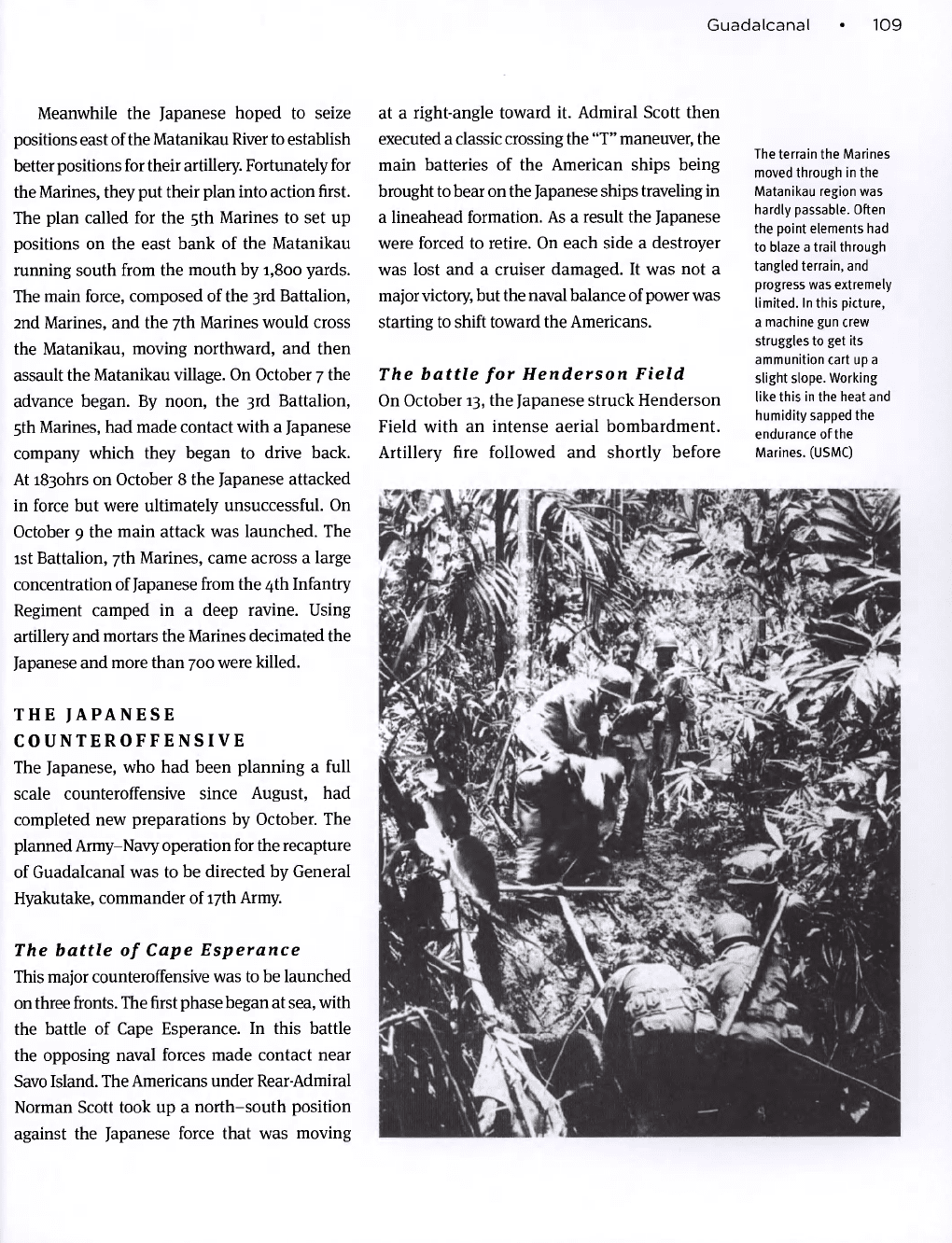
Guadalcanal • 109
Meanwhile the Japanese hoped to seize
positions east of the Matanikau River to establish
better positions for their artillery. Fortunately for
the Marines, they put their plan into action first.
The plan called for the 5th Marines to set up
positions on the east bank of the Matanikau
running south from the mouth by 1,800 yards.
The main force, composed of the 3rd Battalion,
2nd Marines, and the 7th Marines would cross
the Matanikau, moving northward, and then
assault the Matanikau village. On October 7 the
advance began. By noon, the 3rd Battalion,
5th Marines, had made contact with a Japanese
company which they began to drive back.
At i83ohrs on October 8 the Japanese attacked
in force but were ultimately unsuccessful. On
October 9 the main attack was launched. The
1st Battalion, 7th Marines, came across a large
concentration of Japanese from the 4th Infantry
Regiment camped in a deep ravine. Using
artillery and mortars the Marines decimated the
Japanese and more than 700 were killed.
THE JAPANESE
COUNTEROFFENSIVE
The Japanese, who had been planning a full
scale counteroffensive since August, had
completed new preparations by October. The
planned Army-Navy operation for the recapture
of Guadalcanal was to be directed by General
Hyakutake, commander of 17th Army.
The battle of Cape Esperance
This major counteroffensive was to be launched
on three
fronts.
The first phase began at sea, with
the battle of Cape Esperance. In this battle
the opposing naval forces made contact near
Savo Island. The Americans under Rear-Admiral
Norman Scott took up a north-south position
against the Japanese force that was moving
at a right-angle toward it. Admiral Scott then
executed a classic crossing the "T" maneuver, the
main batteries of the American ships being
brought to bear on the Japanese ships traveling in
a lineahead formation. As a result the Japanese
were forced to retire. On each side a destroyer
was lost and a cruiser damaged. It was not a
major victory, but the naval balance of power was
starting to shift toward the Americans.
The battle for Henderson Field
On October 13, the Japanese struck Henderson
Field with an intense aerial bombardment.
Artillery fire followed and shortly before
The terrain the Marines
moved through in the
Matanikau region was
hardly passable. Often
the point elements had
to blaze a trail through
tangled terrain, and
progress was extremely
limited. In this picture,
a machine gun crew
struggles to get its
ammunition cart up a
slight slope. Working
like this in the heat and
humidity sapped the
endurance of the
Marines. (USMC)
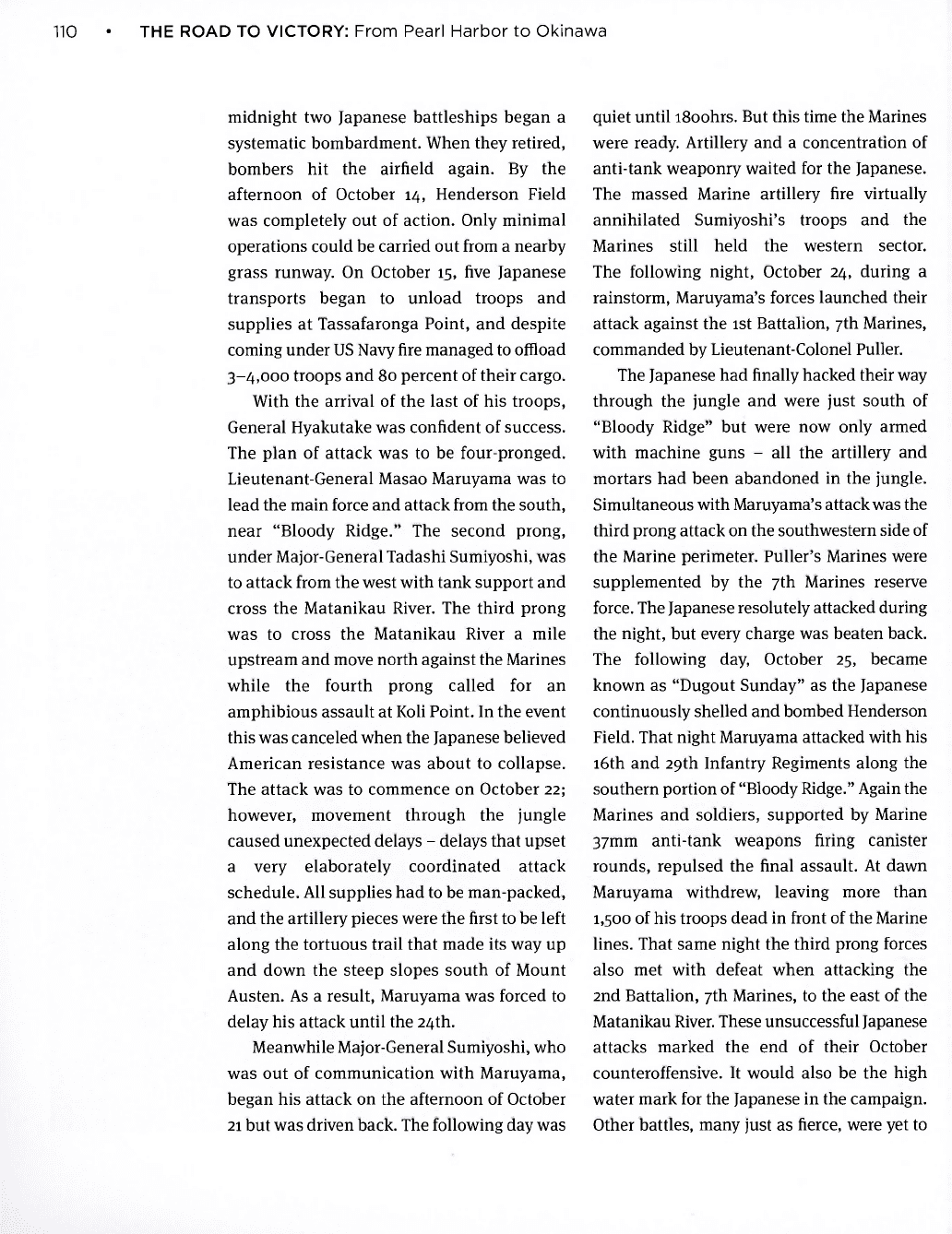
110 • THE ROAD TO VICTORY: From Pearl Harbor to Okinawa
midnight two Japanese battleships began a
systematic bombardment. When they retired,
bombers hit the airfield again. By the
afternoon of October 14, Henderson Field
was completely out of action. Only minimal
operations could be carried out from a nearby
grass runway. On October 15, five Japanese
transports began to unload troops and
supplies at Tassafaronga Point, and despite
coming under US Navy fire managed to offload
3-4,000 troops and 80 percent of their cargo.
With the arrival of the last of his troops,
General Hyakutake was confident of success.
The plan of attack was to be four-pronged.
Lieutenant-General Masao Maruyama was to
lead the main force and attack from the south,
near "Bloody Ridge." The second prong,
under Major-General Tadashi Sumiyoshi, was
to attack from the west with tank support and
cross the Matanikau River. The third prong
was to cross the Matanikau River a mile
upstream and move north against the Marines
while the fourth prong called for an
amphibious assault at Koli Point. In the event
this was canceled when the Japanese believed
American resistance was about to collapse.
The attack was to commence on October 22;
however, movement through the jungle
caused unexpected delays - delays that upset
a very elaborately coordinated attack
schedule. All supplies had to be man-packed,
and the artillery pieces were the first to be left
along the tortuous trail that made its way up
and down the steep slopes south of Mount
Austen. As a result, Maruyama was forced to
delay his attack until the 24th.
Meanwhile Major-General Sumiyoshi, who
was out of communication with Maruyama,
began his attack on the afternoon of October
21 but was driven back. The following day was
quiet until i8oohrs. But this time the Marines
were ready. Artillery and a concentration of
anti-tank weaponry waited for the Japanese.
The massed Marine artillery fire virtually
annihilated Sumiyoshi's troops and the
Marines still held the western sector.
The following night, October 24, during a
rainstorm, Maruyama's forces launched their
attack against the 1st Battalion, 7th Marines,
commanded by Lieutenant-Colonel Puller.
The Japanese had finally hacked their way
through the jungle and were just south of
"Bloody Ridge" but were now only armed
with machine guns - all the artillery and
mortars had been abandoned in the jungle.
Simultaneous with Maruyama's attack was the
third prong attack on the southwestern side of
the Marine perimeter. Puller's Marines were
supplemented by the 7th Marines reserve
force. The Japanese resolutely attacked during
the night, but every charge was beaten back.
The following day, October 25, became
known as "Dugout Sunday" as the Japanese
continuously shelled and bombed Henderson
Field. That night Maruyama attacked with his
16th and 29th Infantry Regiments along the
southern portion of "Bloody Ridge." Again the
Marines and soldiers, supported by Marine
37mm anti-tank weapons firing canister
rounds, repulsed the final assault. At dawn
Maruyama withdrew, leaving more than
1,500 of his troops dead in front of the Marine
lines. That same night the third prong forces
also met with defeat when attacking the
2nd Battalion, 7th Marines, to the east of the
Matanikau River. These unsuccessful Japanese
attacks marked the end of their October
counteroffensive. It would also be the high
water mark for the Japanese in the campaign.
Other battles, many just as fierce, were yet to
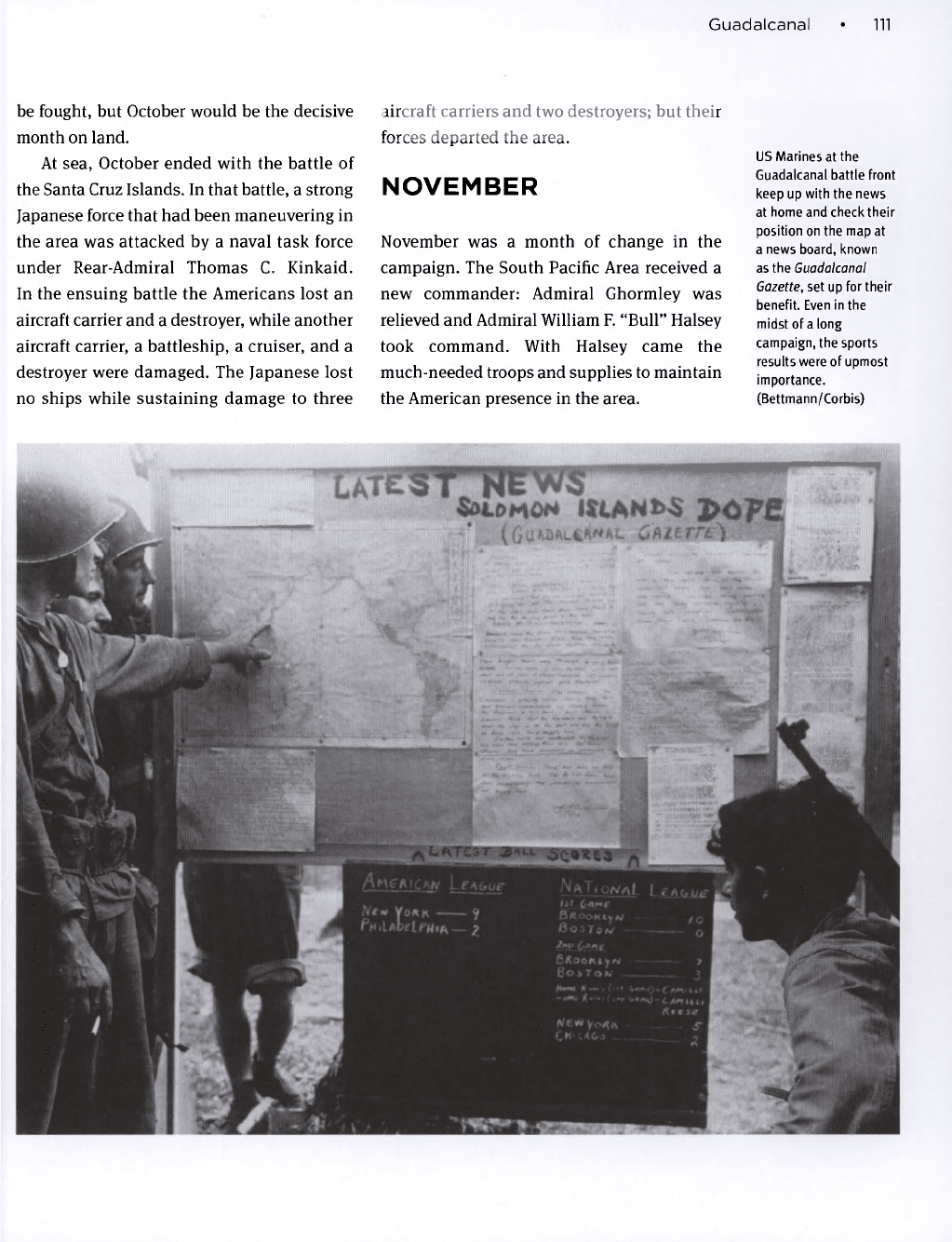
Guadalcanal • 111
be fought, but October would be the decisive
month on land.
At sea, October ended with the battle of
the Santa Cruz Islands. In that battle, a strong
Japanese force that had been maneuvering in
the area was attacked by a naval task force
under Rear-Admiral Thomas C. Kinkaid.
In the ensuing battle the Americans lost an
aircraft carrier and a destroyer, while another
aircraft carrier, a battleship, a cruiser, and a
destroyer were damaged. The Japanese lost
no ships while sustaining damage to three
aircraft carriers and two destroyers; but their
forces departed the area.
NOVEMBER
November was a month of change in the
campaign. The South Pacific Area received a
new commander: Admiral Ghormley was
relieved and Admiral William F. "Bull" Halsey
took command. With Halsey came the
much-needed troops and supplies to maintain
the American presence in the area.
US Marines at the
Guadalcanal battle front
keep up with the news
at home and check their
position on the map at
a news board, known
as the Guadalcanal
Gazette, set up for their
benefit. Even in the
midst of a long
campaign, the sports
results were of upmost
importance.
(Bettmann/Corbis)
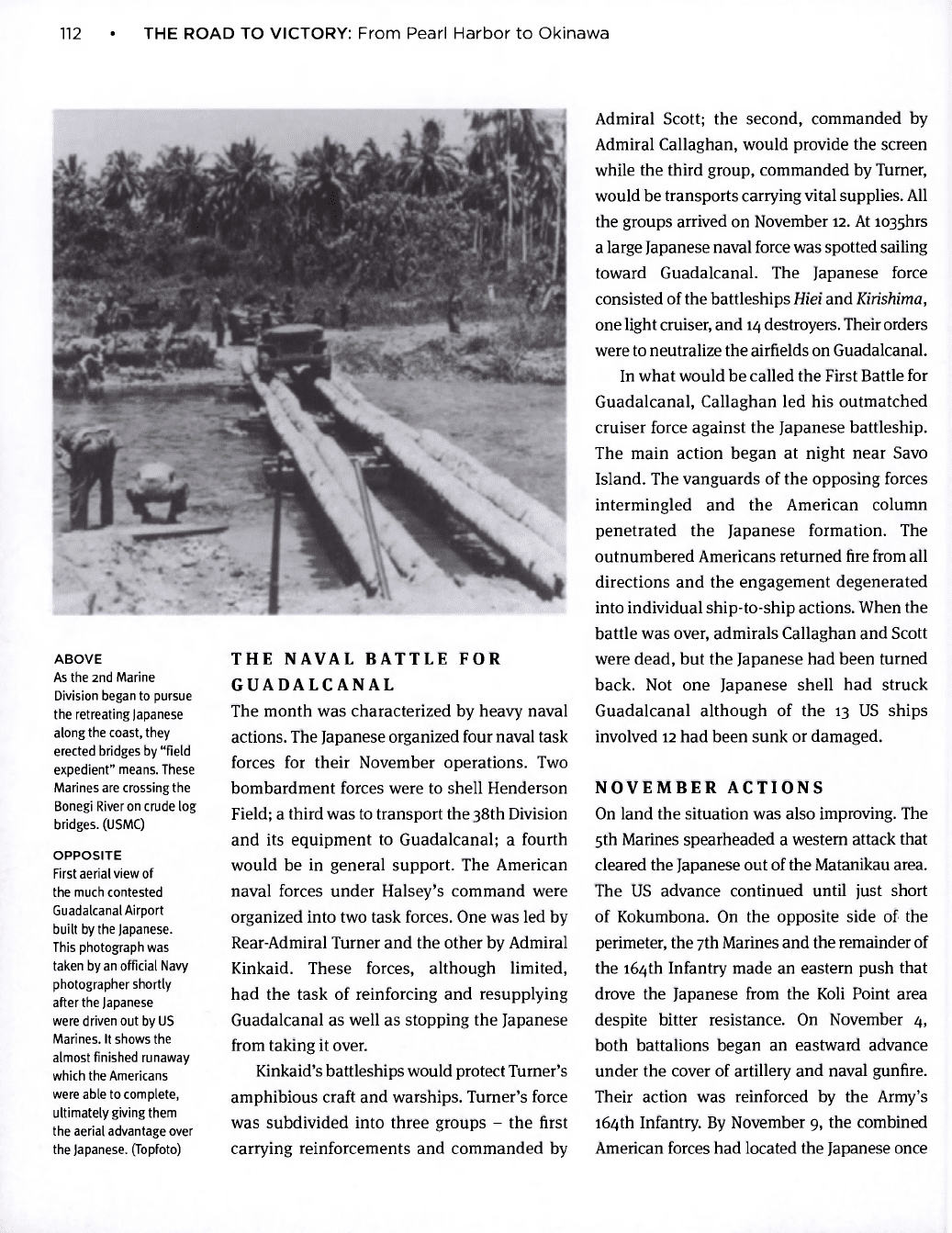
112 • THE ROAD TO VICTORY: From Pearl Harbor to Okinawa
Admiral Scott; the second, commanded by
Admiral Callaghan, would provide the screen
while the third group, commanded by Turner,
would be transports carrying vital supplies. All
the groups arrived on November 12. At i035hrs
a large Japanese naval force was spotted sailing
toward Guadalcanal. The Japanese force
consisted of the battleships Hiei and Kirishima,
one light cruiser, and 14 destroyers. Their orders
were to neutralize the airfields on Guadalcanal.
In what would be called the First Battle for
Guadalcanal, Callaghan led his outmatched
cruiser force against the Japanese battleship.
The main action began at night near Savo
Island. The vanguards of the opposing forces
intermingled and the American column
penetrated the Japanese formation. The
outnumbered Americans returned fire from all
directions and the engagement degenerated
into individual ship-to-ship actions. When the
battle was over, admirals Callaghan and Scott
were dead, but the Japanese had been turned
back. Not one Japanese shell had struck
Guadalcanal although of the 13 US ships
involved 12 had been sunk or damaged.
NOVEMBER ACTIONS
On land the situation was also improving. The
5th Marines spearheaded a western attack that
cleared the Japanese out of the Matanikau area.
The US advance continued until just short
of Kokumbona. On the opposite side of the
perimeter, the 7th Marines and the remainder of
the 164th Infantry made an eastern push that
drove the Japanese from the Koli Point area
despite bitter resistance. On November 4,
both battalions began an eastward advance
under the cover of artillery and naval gunfire.
Their action was reinforced by the Army's
164th Infantry. By November 9, the combined
American forces had located the Japanese once
THE NAVAL BATTLE FOR
GUADALCANAL
The month was characterized by heavy naval
actions. The Japanese organized four naval task
forces for their November operations. Two
bombardment forces were to shell Henderson
Field; a third was to transport the 38th Division
and its equipment to Guadalcanal; a fourth
would be in general support. The American
naval forces under Halsey's command were
organized into two task forces. One was led by
Rear-Admiral Turner and the other by Admiral
Kinkaid. These forces, although limited,
had the task of reinforcing and resupplying
Guadalcanal as well as stopping the Japanese
from taking it over.
Kinkaid's battleships would protect Turner's
amphibious craft and warships. Turner's force
was subdivided into three groups - the first
carrying reinforcements and commanded by
ABOVE
As the 2nd Marine
Division began to pursue
the retreating Japanese
along the coast, they
erected bridges by "field
expedient" means. These
Marines are crossing the
Bonegi River on crude log
bridges. (USMC)
OPPOSITE
First aerial view of
the much contested
Guadalcanal Airport
built by the Japanese.
This photograph was
taken by an official Navy
photographer shortly
after the Japanese
were driven out by US
Marines. It shows the
almost finished runaway
which the Americans
were able to complete,
ultimately giving them
the aerial advantage over
the Japanese. (Topfoto)
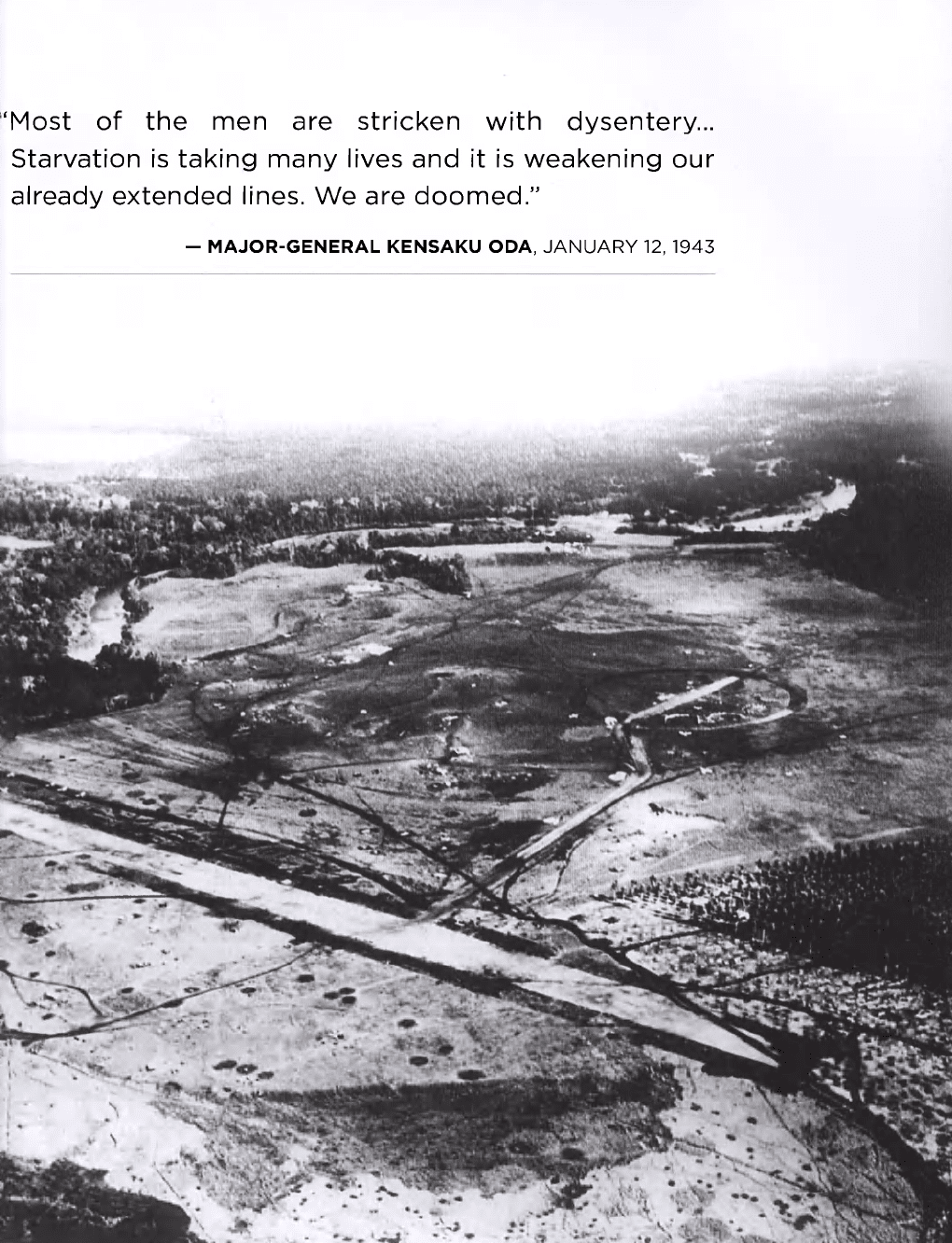
'Most of the men are stricken with dysentery...
Starvation is taking many lives and it is weakening our
already extended lines. We are doomed."
- MAJOR-GENERAL KENSAKU ODA, JANUARY
12,
1943
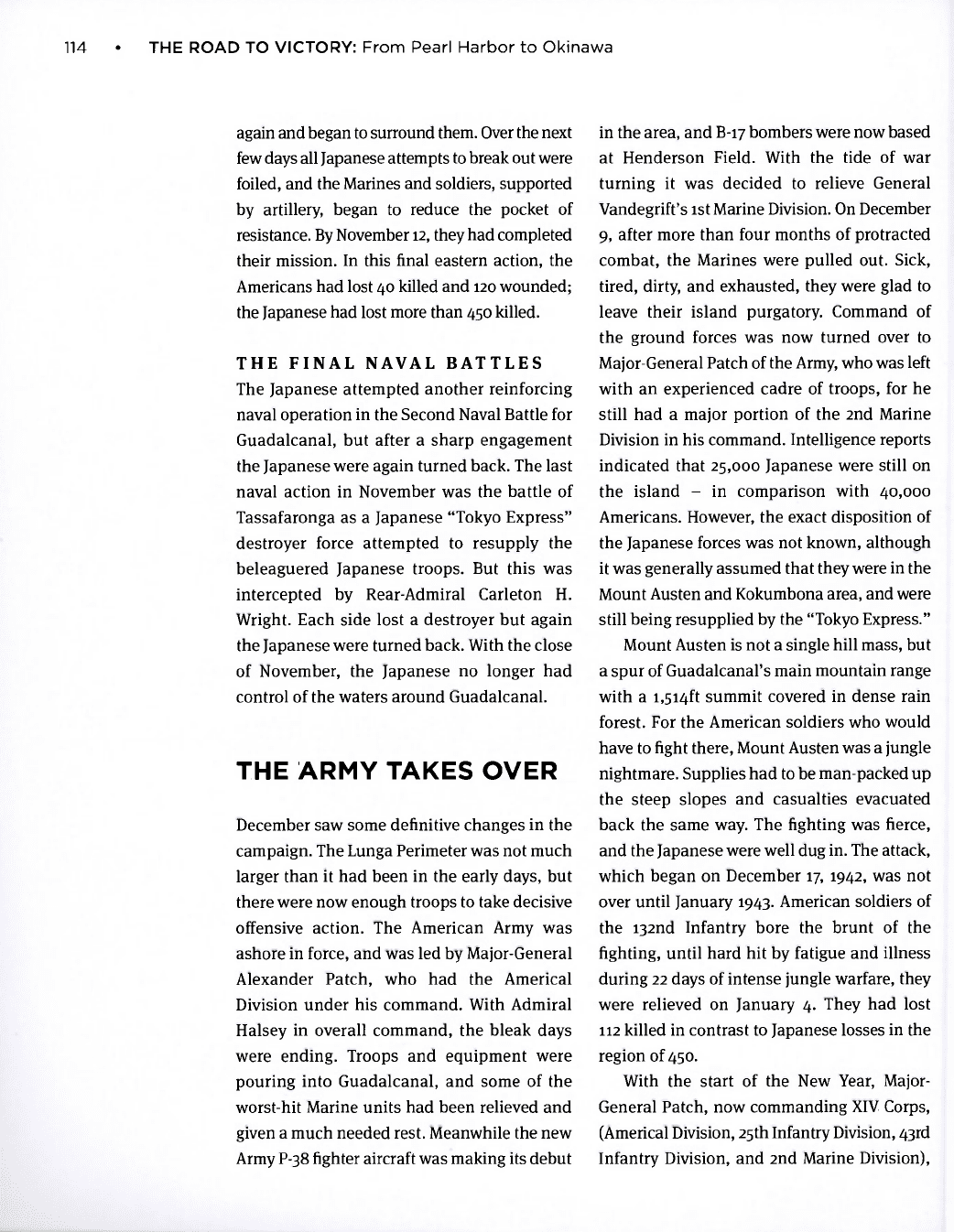
114 • THE ROAD TO VICTORY: From Pearl Harbor to Okinawa
again and began to surround them. Over the next
few days all Japanese attempts to break out were
foiled, and the Marines and soldiers, supported
by artillery, began to reduce the pocket of
resistance. By November 12, they had completed
their mission. In this final eastern action, the
Americans had lost 40 killed and 120 wounded;
the Japanese had lost more than 450 killed.
THE FINAL NAVAL BATTLES
The Japanese attempted another reinforcing
naval operation in the Second Naval Battle for
Guadalcanal, but after a sharp engagement
the Japanese were again turned back. The last
naval action in November was the battle of
Tassafaronga as a Japanese "Tokyo Express"
destroyer force attempted to resupply the
beleaguered Japanese troops. But this was
intercepted by Rear-Admiral Carleton H.
Wright. Each side lost a destroyer but again
the Japanese were turned back. With the close
of November, the Japanese no longer had
control of the waters around Guadalcanal.
THE ARMY TAKES OVER
December saw some definitive changes in the
campaign. The Lunga Perimeter was not much
larger than it had been in the early days, but
there were now enough troops to take decisive
offensive action. The American Army was
ashore in force, and was led by Major-General
Alexander Patch, who had the Americal
Division under his command. With Admiral
Halsey in overall command, the bleak days
were ending. Troops and equipment were
pouring into Guadalcanal, and some of the
worst-hit Marine units had been relieved and
given a much needed rest. Meanwhile the new
Army P-38 fighter aircraft was making its debut
in the area, and B-17 bombers were now based
at Henderson Field. With the tide of war
turning it was decided to relieve General
Vandegrift's 1st Marine Division. On December
9, after more than four months of protracted
combat, the Marines were pulled out. Sick,
tired, dirty, and exhausted, they were glad to
leave their island purgatory. Command of
the ground forces was now turned over to
Major-General Patch of the Army, who was left
with an experienced cadre of troops, for he
still had a major portion of the 2nd Marine
Division in his command. Intelligence reports
indicated that 25,000 Japanese were still on
the island - in comparison with 40,000
Americans. However, the exact disposition of
the Japanese forces was not known, although
it was generally assumed that they were in the
Mount Austen and Kokumbona area, and were
still being resupplied by the "Tokyo Express."
Mount Austen is not a single hill mass, but
a spur of Guadalcanal's main mountain range
with a 1,514ft summit covered in dense rain
forest. For the American soldiers who would
have to fight there, Mount Austen was a jungle
nightmare. Supplies had to be man-packed up
the steep slopes and casualties evacuated
back the same way. The fighting was fierce,
and the Japanese were well dug in. The attack,
which began on December 17, 1942, was not
over until January 1943. American soldiers of
the 132nd Infantry bore the brunt of the
fighting, until hard hit by fatigue and illness
during 22 days of intense jungle warfare, they
were relieved on January 4. They had lost
112 killed in contrast to Japanese losses in the
region of 450.
With the start of the New Year, Major-
General Patch, now commanding XIV Corps,
(Americal Division, 25th Infantry Division, 43rd
Infantry Division, and 2nd Marine Division),
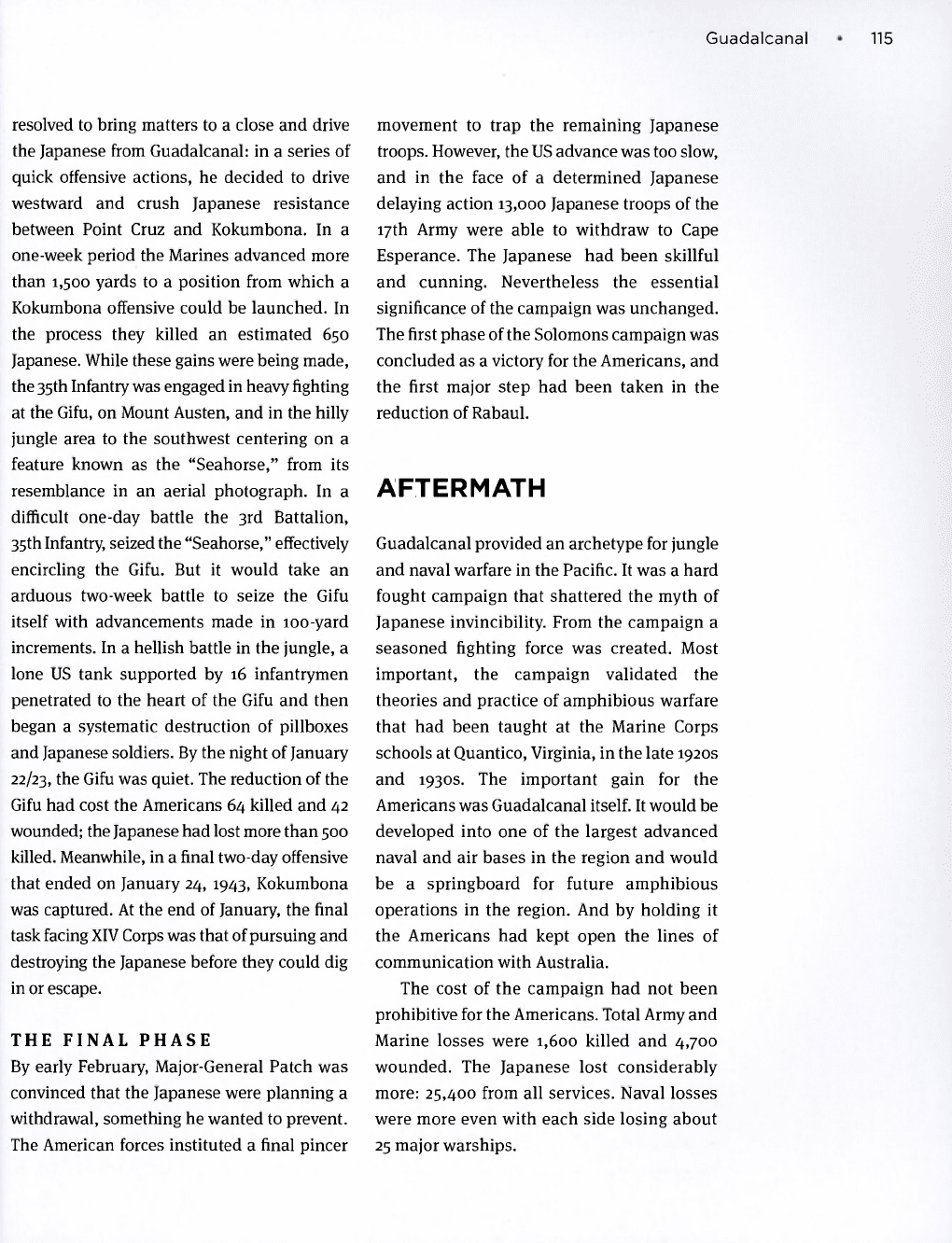
Guadalcanal • 115
resolved to bring matters to a close and drive
the Japanese from Guadalcanal: in a series of
quick offensive actions, he decided to drive
westward and crush Japanese resistance
between Point Cruz and Kokumbona. In a
one-week period the Marines advanced more
than 1,500 yards to a position from which a
Kokumbona offensive could be launched. In
the process they killed an estimated 650
Japanese. While these gains were being made,
the 35th Infantry was engaged in heavy fighting
at the Gifu, on Mount Austen, and in the hilly
jungle area to the southwest centering on a
feature known as the "Seahorse," from its
resemblance in an aerial photograph. In a
difficult one-day battle the 3rd Battalion,
35th Infantry, seized the "Seahorse," effectively
encircling the Gifu. But it would take an
arduous two-week battle to seize the Gifu
itself with advancements made in 100-yard
increments. In a hellish battle in the jungle, a
lone US tank supported by 16 infantrymen
penetrated to the heart of the Gifu and then
began a systematic destruction of pillboxes
and Japanese soldiers. By the night of January
22/23, the Gifu was quiet. The reduction of the
Gifu had cost the Americans 64 killed and 42
wounded; the Japanese had lost more than 500
killed. Meanwhile, in a final two-day offensive
that ended on January 24, 1943, Kokumbona
was captured. At the end of January, the final
task facing XIV Corps was that of pursuing and
destroying the Japanese before they could dig
in or escape.
THE FINAL PHASE
By early February, Major-General Patch was
convinced that the Japanese were planning a
withdrawal, something he wanted to prevent.
The American forces instituted a final pincer
movement to trap the remaining Japanese
troops. However, the US advance was too slow,
and in the face of a determined Japanese
delaying action 13,000 Japanese troops of the
17th Army were able to withdraw to Cape
Esperance. The Japanese had been skillful
and cunning. Nevertheless the essential
significance of the campaign was unchanged.
The first phase of the Solomons campaign was
concluded as a victory for the Americans, and
the first major step had been taken in the
reduction of Rabaul.
AFTERMATH
Guadalcanal provided an archetype for jungle
and naval warfare in the Pacific. It was a hard
fought campaign that shattered the myth of
Japanese invincibility. From the campaign a
seasoned fighting force was created. Most
important, the campaign validated the
theories and practice of amphibious warfare
that had been taught at the Marine Corps
schools at Quantico, Virginia, in the late 1920s
and 1930s. The important gain for the
Americans was Guadalcanal itself. It would be
developed into one of the largest advanced
naval and air bases in the region and would
be a springboard for future amphibious
operations in the region. And by holding it
the Americans had kept open the lines of
communication with Australia.
The cost of the campaign had not been
prohibitive for the Americans. Total Army and
Marine losses were 1,600 killed and 4,700
wounded. The Japanese lost considerably
more: 25,400 from all services. Naval losses
were more even with each side losing about
25 major warships.
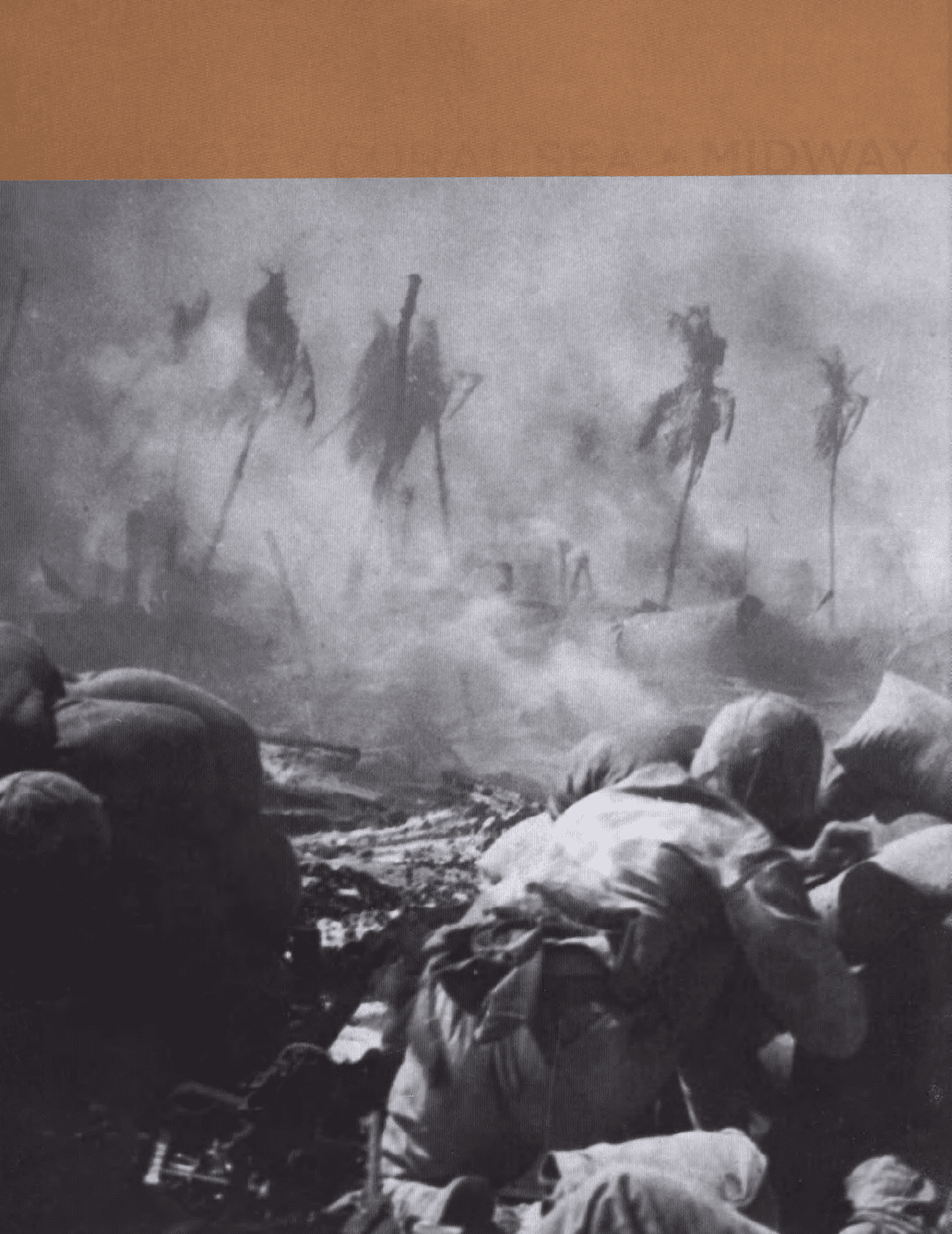
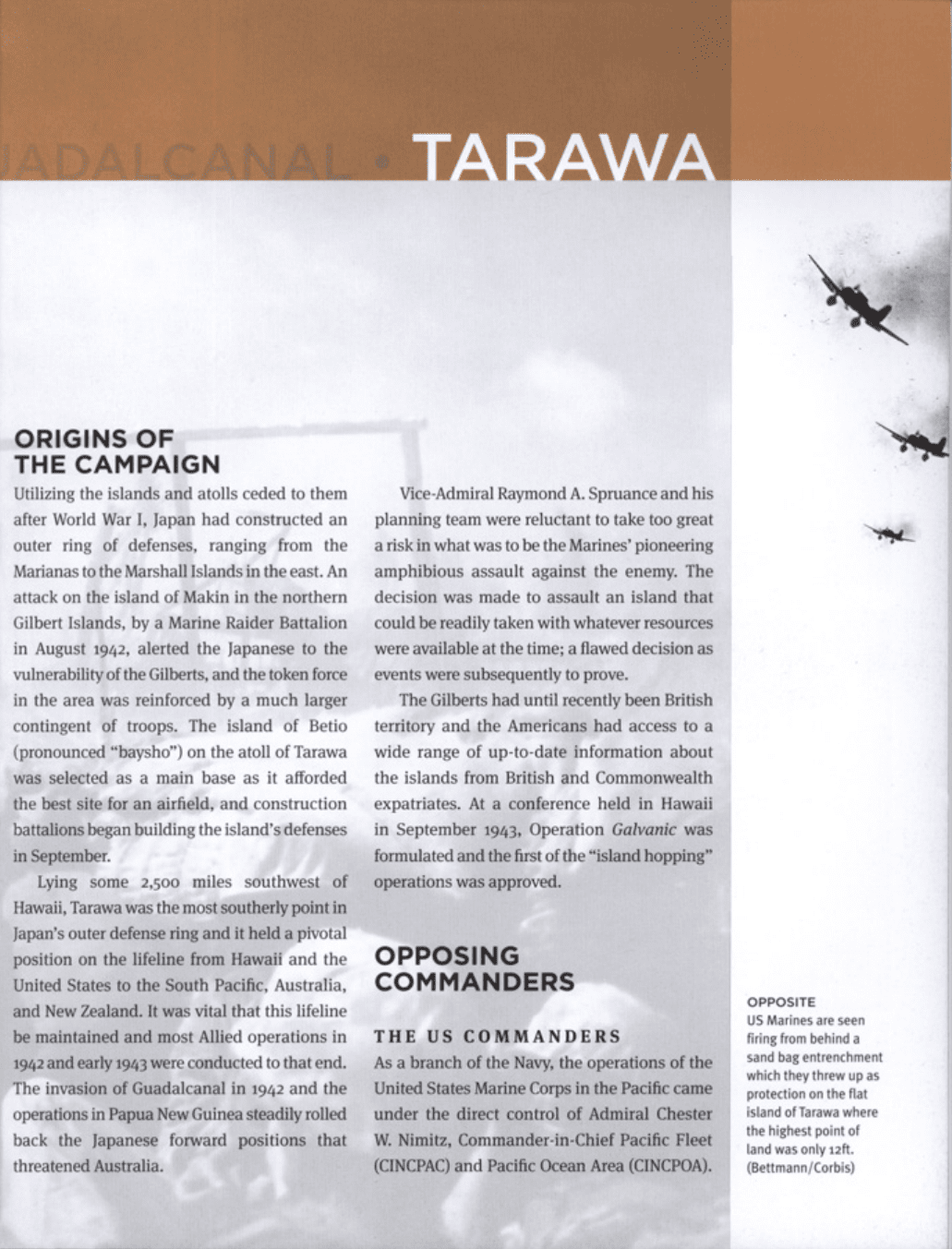
ORIGINS OF
THE CAMPAIGN
Utilizing the islands and atolls ceded to them
after World War I, Japan had constructed an
outer ring of defenses, ranging from the
Marianas to the Marshall Islands in the east. An
attack on the island of Makin in the northern
Gilbert Islands, by a Marine Raider Battalion
in August 1942, alerted the Japanese to the
vulnerability of
the
Gilberts, and the token force
in the area was reinforced by a much larger
contingent of troops. The island of Betio
(pronounced "baysho") on the atoll of Tarawa
was selected as a main base as it afforded
the best site for an airfield, and construction
battalions began building the island's defenses
in September.
Lying some 2,500 miles southwest of
Hawaii, Tarawa was the most southerly point in
Japan's outer defense ring and it held a pivotal
position on the lifeline from Hawaii and the
United States to the South Pacific, Australia,
and New Zealand. It was vital that this lifeline
be maintained and most Allied operations in
1942 and early 1943 were conducted to that end.
The invasion of Guadalcanal in 1942 and the
operations in Papua New Guinea steadily rolled
back the Japanese forward positions that
threatened Australia.
Vice-Admiral Raymond A. Spruance and his
planning team were reluctant to take too great
a risk in what was to be the Marines' pioneering
amphibious assault against the enemy. The
decision was made to assault an island that
could be readily taken with whatever resources
were available at the time; a flawed decision as
events were subsequently to prove.
The Gilberts had until recently been British
territory and the Americans had access to a
wide range of up-to-date information about
the islands from British and Commonwealth
expatriates. At a conference held in Hawaii
in September 1943, Operation Galvanic was
formulated and the first of the "island hopping"
operations was approved.
OPPOSING
COMMANDERS
THE US COMMANDERS
As a branch of the Navy, the operations of the
United States Marine Corps in the Pacific came
under the direct control of Admiral Chester
W. Nimitz, Commander-in-Chief Pacific Fleet
(CINCPAC) and Pacific Ocean Area (CINCPOA).
OPPOSITE
US Marines are seen
firing from behind a
sand bag entrenchment
which they threw up as
protection on the flat
island of Tarawa where
the highest point of
land was only 12ft.
(Bettmann/Corbis)
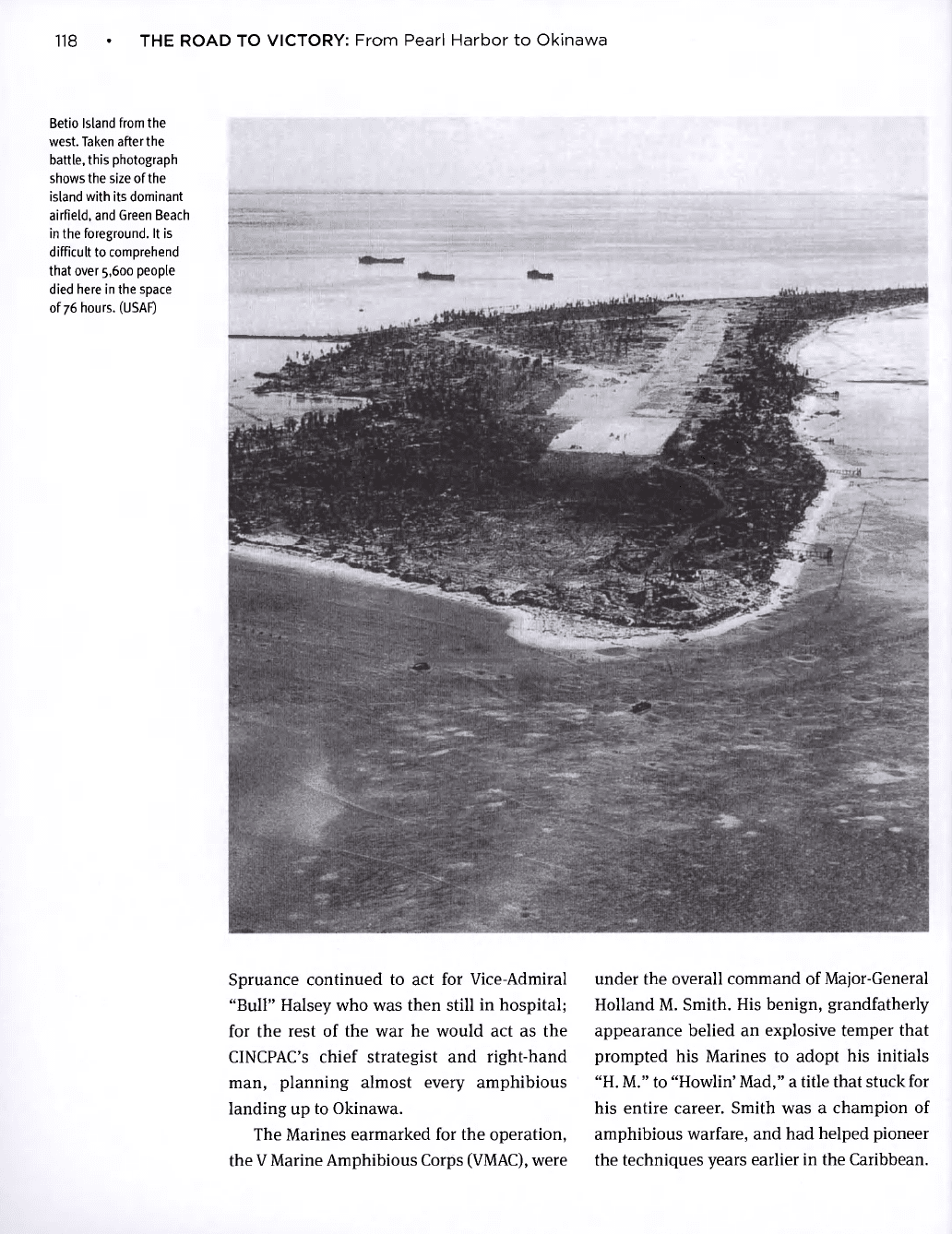
118 • THE ROAD TO VICTORY: From Pearl Harbor to Okinawa
Betio Island from the
west. Taken after the
battle, this photograph
shows the size of the
island with its dominant
airfield, and Green Beach
in the foreground. It is
difficult to comprehend
that over 5,600 people
died here in the space
of 76 hours. (USAF)
Spruance continued to act for Vice-Admiral
"Bull" Halsey who was then still in hospital;
for the rest of the war he would act as the
CINCPAC's chief strategist and right-hand
man, planning almost every amphibious
landing up to Okinawa.
The Marines earmarked for the operation,
the V Marine Amphibious Corps (VMAC), were
under the overall command of Major-General
Holland M. Smith. His benign, grandfatherly
appearance belied an explosive temper that
prompted his Marines to adopt his initials
"H. M." to "Howlin' Mad," a title that stuck for
his entire career. Smith was a champion of
amphibious warfare, and had helped pioneer
the techniques years earlier in the Caribbean.
